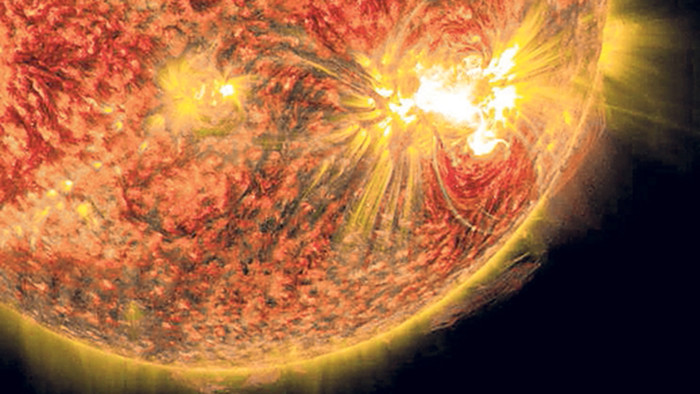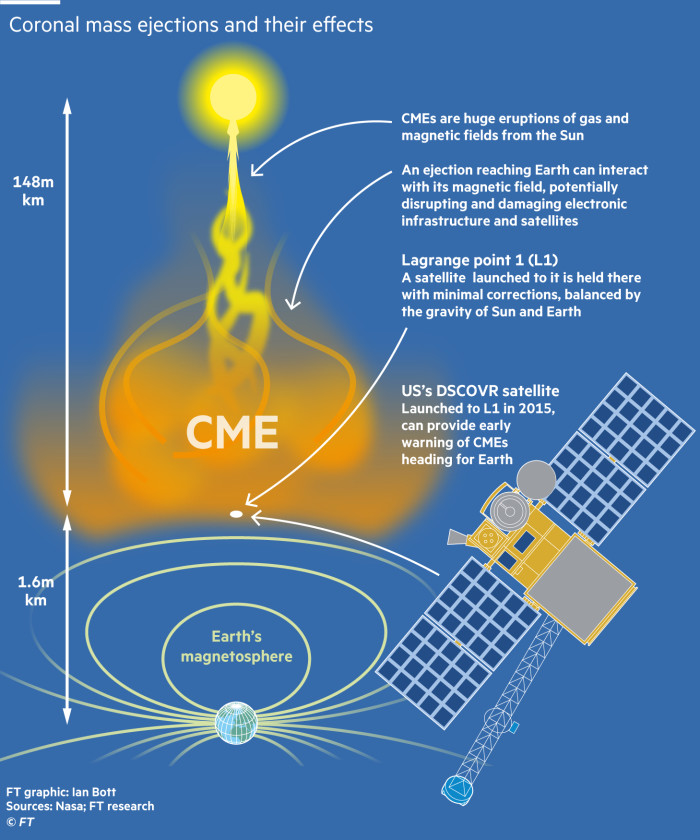Sun’s flares pose astronomical risk to comms networks

Roula Khalaf, Editor of the FT, selects her favourite stories in this weekly newsletter.
Most of us think every day about the weather on Earth, if only to adjust our clothing to the heat or the threat of rain. The destructive power of extreme weather, from storms to heatwaves, frequently catches our attention through the media and occasionally, if we are unlucky, we suffer its impact directly.
Some scientists, though, worry more about “space weather”, which originates in the turbulent atmosphere of the thermonuclear reactor that we call the Sun. Severe space weather storms triggered by intense solar activity occur much less frequently than terrestrial tempests, but in the worst case they could be even more destructive.
If a huge eruption of energy and electrically charged particles from the Sun, known as a coronal mass ejection (CME), hits Earth, it can cause an intense electromagnetic storm around the planet (see graphic). The impact of the particles and oscillations of Earth’s magnetic field on the electronic infrastructure underlying modern industrial civilisation could be devastating.
The greatest solar storm on record, the so-called Carrington event of 1859, wrecked the world’s newly installed telegraph networks. A repeat today would cost trillions of dollars as power grids, communications satellites and electronic equipment worldwide are knocked out. Space scientists believe such severe storms hit Earth once every couple of centuries on average.
The most serious event in modern times came in 1989, when wild voltage fluctuations caused the Hydro-Québec grid in Canada to collapse, leaving millions of people without electricity for nine hours. Adverse space weather has also triggered several smaller blackouts and satellite failures in recent years.
“During a big geomagnetic storm in 2003, a Japanese scientific satellite was lost and 10 per cent of the world’s satellite fleet suffered malfunctions,” says Professor Richard Horne of the British Antarctic Survey. Antarctica provides an excellent base for observing and measuring the disruptions to Earth’s upper atmosphere during solar storms.

“Today we have around 1,500 satellites in orbit, with thousands more due to be launched in the next few years,” Prof Horne adds. “People are trying to use more commercial off-the-shelf components, rather than components made to operate in space, and many systems have not been tested in a major storm, so there is a lot of uncertainty about what might happen.”
A recent unfortunate coincidence of adverse space and Earth weather came on September 6 and 10 in 2017, when powerful flares erupted from the surface of the Sun and caused short wave radio blackouts for several hours — hampering the emergency response to hurricanes ravaging the Caribbean.
“The Sun’s been very quiet for the last 10 years. It reminds people not to be complacent,” says Mike Hapgood, head of space weather at the UK Rutherford Appleton Laboratory.
Fortunately the world’s space agencies, as well as terrestrial organisations such as the BAS, RAL and UK Meteorological Office, are alive to the threat. Nasa of the US and Esa, the European space agency, are studying the Sun through a series of missions. The latest, Nasa’s $1.5bn Parker Solar Probe, was launched on August 12; it will fly closer to the Sun than any previous craft, swooping inside the glowing corona.
Such space missions aim both to investigate the causes of storms on the Sun and to provide better forecasts of their impending impact on Earth. If operators receive reliable advance warning, they can protect infrastructure to some extent by shutting down some vulnerable components ahead of the storm.
Although scientists can monitor potentially troublesome activity days ahead of a possible eruption, forecasting the path and effects of an actual CME — a gigantic bubble of super-hot particles bursting from the solar surface at several million miles per hour — is very hard. Even if it appears to be heading for Earth, a journey that takes about a day, the impact is very sensitive to small differences in the way solar particles interact with the terrestrial magnetic field.
According to Prof Horne, the most useful satellite for short-term space weather forecasting today is the US Deep Space Climate Observatory, or DSCOVR, launched in 2015 into the so-called L1 orbit, a neutral gravity point between Sun and Earth. From this position about 1m miles from Earth, DSCOVR can provide up to an hour’s warning before a surge of solar particles and magnetic activity causes a geomagnetic storm.
Observations from Earth will be enhanced by a new European space weather radar system called EISCAT-3D to be built in the Norwegian Arctic over the next three years. It will scan the upper atmosphere to monitor the impact of energetic particles and electric currents from space.

Comments